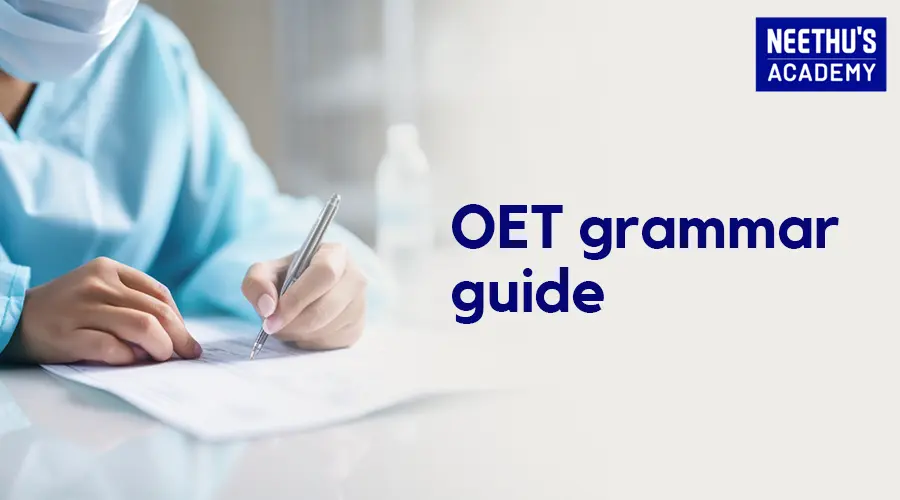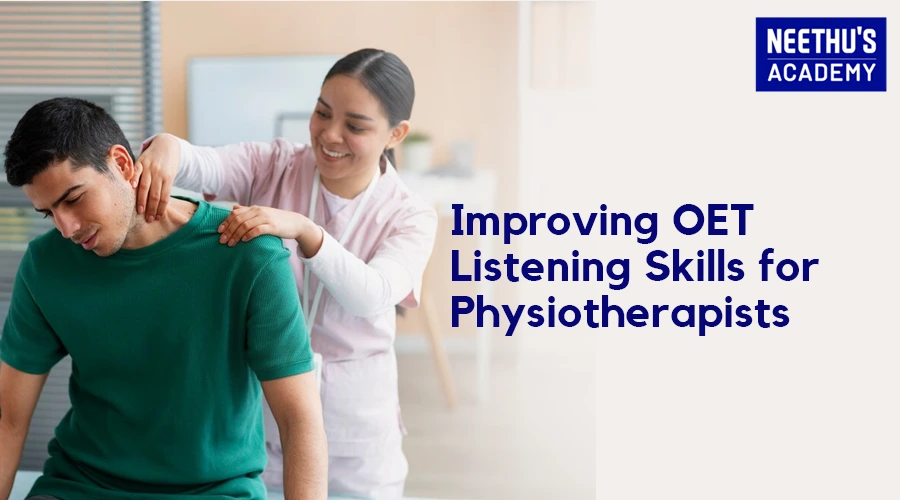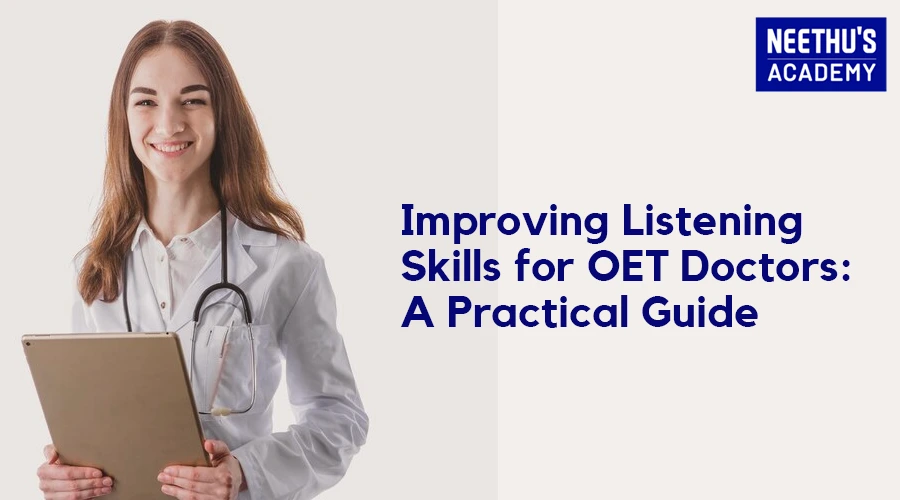How to Master OET Grammar for Success in the OET Test
Grammar is the structural foundation of any language, which gives clarity and coherency to one’s communication. Grammar properly used in OET will provide effectiveness in conveying your ideas, understanding instructions, and communicating with the patient and colleagues. Let’s have a closer look at how grammar makes a difference in each section of OET:
Grammar in OET Listening
Grammar is indispensable in the listening section, which works with spoken English. Tenses, conjunctions, and prepositions will completely alter what you hear. For example, the difference in meaning between “The patient was given medication” and “The patient is given medication” will give you precisely how an action is viewed, whether it is complete or continuous. Good grammar will help you follow a conversation thread accurately, thereby making it easier for you to answer questions about the listening passage.
Grammar in OET Reading
Good grammar is essential for effective reading, particularly in exams like the OET where complex sentence structures are prevalent. Understanding grammar allows you to handle intricate sentences by breaking them into manageable parts, such as clauses and phrases. For example, in a sentence like “Although the patient felt better, the doctor recommended continuing the medication,” recognizing how “although” introduces a contrasting idea helps you grasp the meaning.
Proper grammar also enables you to pinpoint key information and understand how different ideas are linked. Recognizing conjunctions, transitional phrases, and punctuation helps follow the logical flow of the text. This skill is crucial for navigating detailed descriptions and cause-and-effect relationships in the reading section, ensuring you accurately capture the main points and their connections. Mastering grammar not only enhances your comprehension but also improves your ability to answer questions effectively.
Grammar in OET Writing
The writing section of the OET directly evaluates your grammar skills, which are crucial for creating professional documents like referral letters and discharge summaries. Clear and accurate grammar is vital to ensure your writing conveys information precisely, as any mistakes can lead to miscommunication—particularly critical in healthcare settings. Errors in grammar can result in misunderstandings about a patient’s condition or treatment plan, potentially impacting patient care. Therefore, mastering grammar not only improves the readability of your documents but also ensures that your communication is professional and effective, reflecting your competence as a healthcare professional.
Grammar in OET Speaking
In the speaking section, grammar helps you convey your ideas clearly and professionally. Proper sentence structure, verb usage, and tense application are essential for effectively describing patient conditions, giving instructions, and explaining treatment plans. Mastering these grammatical elements ensures that your communication is both accurate and coherent, which is crucial for demonstrating your competence in a healthcare setting.
For instance, instead of saying, “The patient is complaining chest pain,” it would be more transparent and more precise to say, “The patient complains of chest pain.”
Grammar for Effective OET Writing
The writing section is the part where your grammar skills are put under strict scrutiny. Mastering it calls for you to know the following
Subject-Verb Agreement: Verbs and subjects should match in number. That is, for example, “The doctor, along with the nurses, is on duty” is correct, but “The doctor, along with the nurses, are on duty” is not.
Sentence Structure: There must be a subject and a predicate in every sentence. No run-on sentences or fragments should appear. Example: “The patient was admitted to the hospital for treatment. The doctor explained” is correct, whereas the meaning would be more easily understood in “The patient was admitted to the hospital for treatment, and the doctor explained” with more appropriate punctuation.
Correct Use of Articles: Using articles correctly helps to make the meaning clear. “A” or “an” refers to any general item, while “the” points to something specific. For example, “a patient” means any patient, but “the patient” refers to a particular one.
Grammar Tips for OET
Active Voice: Writing in the active voice improves clarity and directness. For example, “The nurse administered the medication” is clearer than “The medication was administered by the nurse.”
Be Brief: There is no need to use any words that are not necessary or make sentences long and complicated. For example, in this sentence, “It is necessary to make sure that the patient is comfortable” can be shortened to “Ensure the patient is comfortable.
Avoid Changes in Tense: Use the appropriate tense when writing your work to avoid any confusion. For example, “The patient was discharged yesterday. They will follow up with their GP next week” makes sense as it follows proper tense.
Use the Article Correctly: The correct use of articles adds clarity. For example, “The patient was tired” is specific, whereas “A patient was tired” is not.
Punctuation Matters: Proper punctuation can help avoid ambiguity. For example, “Let’s eat, Grandma” versus “Let’s eat Grandma” shows how punctuation can change meaning.
Common Grammar Mistakes to Avoid
Subject-Verb Agreement Errors: Subject and verb in number should agree. For example, it should be”The team is ready” and not “The team is ready”.
Incorrect Tense Usage: Avoid confusing tenses. For example, “The patient will have surgery” is future perfect, while “The patient had surgery” is past perfect.
Misplaced Modifiers: Ensure modifiers are placed next to the words they modify. For example, “She nearly drove to every appointment” implies she almost completed the task, whereas “She drove to nearly every appointment” conveys she completed most of them.
Ambiguous Pronouns: One should always use pronouns clearly so that ambiguity can be avoided. For example, “The doctor told the patient to take their medication” should specify “The doctor told the patient to take the patient’s medication” if multiple patients are involved.
Overcoming Pronoun Confusion
Pronoun confusion is perhaps one of the most common issues in OET writing. This is how one could avoid it:
Clarify Antecedents: Make sure each pronoun refers to a specific noun. For example, “Dr. Smith, who was on call, checked the patient” clarifies that “Dr. Smith” is the one who checked the patient.
Use Names When Necessary: In contexts with multiple individuals, using names rather than pronouns can enhance clarity. For example, “Dr. Smith told Nurse Brown to prepare the patient” is clearer than “He told her to prepare the patient.”
Avoid Overusing Pronouns: Balance pronoun use with clear references to avoid confusion. Instead of “He said that he would do it,” specify “Dr. Smith said that he would complete the task.”
To sum things up
Mastering grammar is key to succeeding in the OET and ensuring your communication is clear, professional, and effective in a healthcare setting. By focusing on the grammar tips and strategies we’ve covered, you’ll be better equipped to handle each section of the exam with confidence. Remember, good grammar isn’t just about getting the right answers, it’s about ensuring that your message is understood and that you can provide the best care to your patients. Keep practicing, use the resources available, and you’ll see great results in your OET journey.
Frequently Asked Questions





